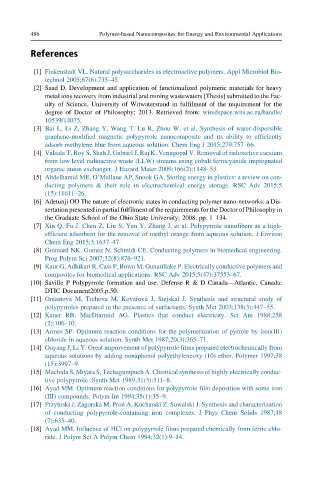Page 533 - Polymer-based Nanocomposites for Energy and Environmental Applications
P. 533
486 Polymer-based Nanocomposites for Energy and Environmental Applications
References
[1] Finkenstadt VL. Natural polysaccharides as electroactive polymers. Appl Microbiol Bio-
technol 2005;67(6):735–45.
[2] Saad D. Development and application of functionalized polymeric materials for heavy
metal ions recovery from industrial and mining wastewaters [Thesis] submitted to the Fac-
ulty of Science, University of Witwatersrand in fulfilment of the requirement for the
degree of Doctor of Philosophy; 2013. Retrieved from: wiredspace.wits.ac.za/handle/
10539/14075.
[3] Bai L, Li Z, Zhang Y, Wang T, Lu R, Zhou W, et al. Synthesis of water-dispersible
graphene-modified magnetic polypyrrole nanocomposite and its ability to efficiently
adsorb methylene blue from aqueous solution. Chem Eng J 2015;279:757–66.
[4] Valsala T, Roy S, Shah J, Gabriel J, Raj K, Venugopal V. Removal of radioactive caesium
from low level radioactive waste (LLW) streams using cobalt ferrocyanide impregnated
organic anion exchanger. J Hazard Mater 2009;166(2):1148–53.
[5] Abdelhamid ME, O’Mullane AP, Snook GA. Storing energy in plastics: a review on con-
ducting polymers & their role in electrochemical energy storage. RSC Adv 2015;5
(15):11611–26.
[6] Adetunji OO The nature of electronic states in conducting polymer nano-networks: a Dis-
sertation presented in partial fulfilment of the requirements for the Doctor of Philosophy in
the Graduate School of the Ohio State University; 2008. pp. 1–134.
[7] Xin Q, Fu J, Chen Z, Liu S, Yan Y, Zhang J, et al. Polypyrrole nanofibers as a high-
efficient adsorbent for the removal of methyl orange from aqueous solution. J Environ
Chem Eng 2015;3:1637–47.
[8] Guimard NK, Gomez N, Schmidt CE. Conducting polymers in biomedical engineering.
Prog Polym Sci 2007;32(8):876–921.
[9] Kaur G, Adhikari R, Cass P, Bown M, Gunatillake P. Electrically conductive polymers and
composites for biomedical applications. RSC Adv 2015;5(47):37553–67.
[10] Saville P Polypyrrole formation and use. Defense R & D Canada—Atlantic, Canada:
DTIC Document2005.p.50.
[11] Omastova M, Trchova M, Kova ´ rova ´ J, Stejskal J. Synthesis and structural study of
polypyrroles prepared in the presence of surfactants. Synth Met 2003;138(3):447–55.
[12] Kaner RB, MacDiarmid AG. Plastics that conduct electricity. Sci Am 1988;258
(2):106–10.
[13] Armes SP. Optimum reaction conditions for the polymerization of pyrrole by iron(III)
chloride in aqueous solution. Synth Met 1987;20(3):365–71.
[14] Ouyang J, Li Y. Great improvement of polypyrrole films prepared electrochemically from
aqueous solutions by adding nonaphenol polyethyleneoxy (10) ether. Polymer 1997;38
(15):3997–9.
[15] Machida S, Miyata S, Techagumpuch A. Chemical synthesis of highly electrically conduc-
tive polypyrrole. Synth Met 1989;31(3):311–8.
[16] Ayad MM. Optimum reaction conditions for polypyrrole film deposition with some iron
(III) compounds. Polym Int 1994;35(1):35–9.
[17] Przyłuski J, Zagorska M, Pro n A, Kucharski Z, Suwalski J. Synthesis and characterization
of conducting polypyrrole-containing iron complexes. J Phys Chem Solids 1987;48
(7):635–40.
[18] Ayad MM. Influence of HCl on polypyrrole films prepared chemically from ferric chlo-
ride. J Polym Sci A Polym Chem 1994;32(1):9–14.

